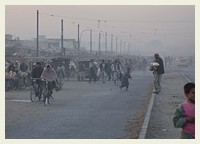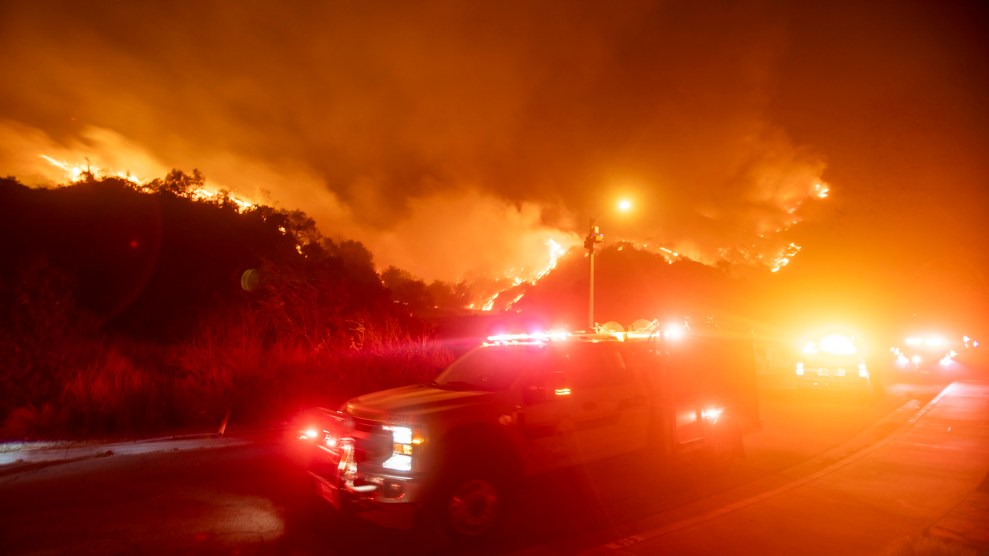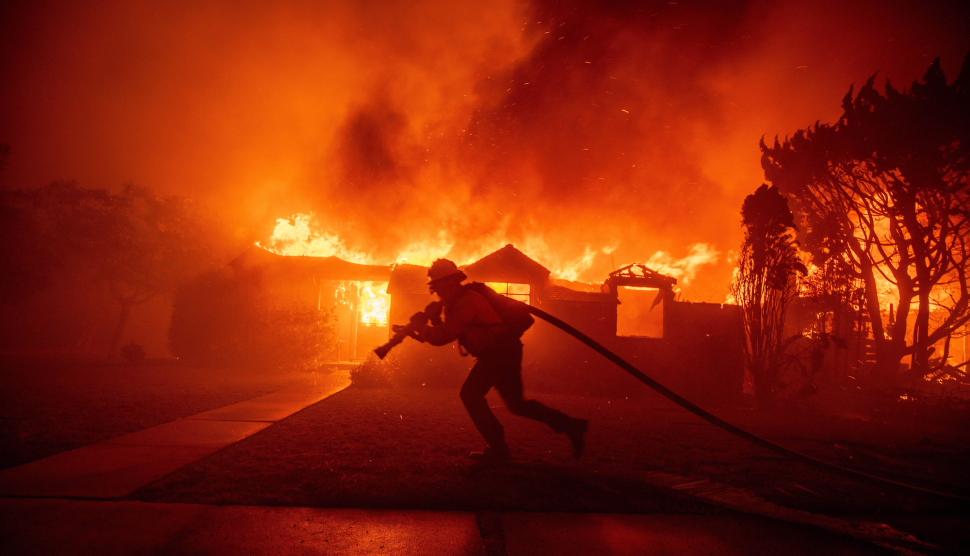
Image: Michael Kamber
As dusk falls in Kabul, the streets fill with a choking gray smoke, despite the city’s near-complete lack of industry. Nearly every family in this capital of one million is cooking its evening meal and trying to keep the bitter winter chill at bay. But in a partially destroyed city where most homes lack electricity, the only fuel available is wood, cut from the surrounding hillsides and trucked into Kabul and other cities. The interiors of the dilapidated concrete homes — and, presumably the lungs of inhabitants — are covered with soot.
Amid the ongoing US-led campaign against the Taliban and Al Qaeda, little has been said about Afghanistan’s environment. That is a critical oversight, because the landlocked country of 25 million is facing a crippling environmental disaster, one greatly exacerbated by 23 years of war. At this point, another round of civil war could wipe out the country’s forests as well as several endangered species.
“Losses of natural resources are beyond estimation,” says Abdul Wajid Adil, of the Peshawar, Pakistan-based Society for Afghanistan’s Viable Environment (SAVE). “Damage to the environment is second only to human loss.”
A four-year drought has compounded the infrastructural damage caused by fighting, emptying rivers and irrigation canals. With the recently installed government of President Hamid Karzai still exerting only very limited central authority, the hunting of endangered species and widespread smuggling of rare animals that flourished during the chaos of fighting continues unabated. As for the trees, “after very few years the forest will all be gone,” says Adil. In their place, the nearly barren land is seeded with mines and unexploded bombs.
Deforestation is perhaps the most serious environmental problem facing Afghanistan. With many powerplants and electrical lines destroyed, impoverished Afghans have few energy options. Millions of daily cooking fires are devouring the last vestige of the forests that once covered millions of acres of their country.
Environmental organizations recommend that 15 percent of a country be forested to prevent topsoil erosion and sustain air quality. “In Afghanistan, between 1 and 2 percent of the land is forested,” estimates Mohammed Mujib Khan, the head of the International Union for the Conservation of Nature’s office in Sarhad, Pakistan. “This represents a 33 percent decrease from 1979.”
In addition to the local demand, there is a large timber mafia that smuggles wood out of the country. One can stand at the border and watch trucks piled high with logs as they cross into Chaman and Peshawar, small cities in Pakistan. In Afghanistan, where the average income is $280 a year, the cutting of trees is a lucrative business.
|
||
| The remains of a military base in Jalalabad, Afghanistan. |
As the trees are cut, the rich topsoil, previously anchored by roots, is blown away on the wind, or is washed by the rains into nearby tributaries. Crops become stunted, and agricultural production — already damaged by the tendency of refugees to migrate to cities — falls further. This phenomenon is advanced in countries such as Haiti, a nation that once exported large quantities of food to Europe. Today Haiti, deforested and its topsoil gone, imports rice to feed its own people. No one knows how much arable land has been lost in Afghanistan in recent years, but experts warn that if current trends continue, Afghanistan is on its way to a similar fate.
And there is fear as well that the returning refugees — of which there are over three million in neighboring Pakistan, Iran and other countries — will exacerbate the environmental crisis. Rather than return to bombed-out villages and land-mined fields, many refugees will likely converge upon Kabul or other large cities in Afghanistan. Once there, they will place extraordinary demands on a fragile infrastructure, adding to the air pollution and worsening the sanitation crisis in a country where open sewers are the norm. No recent air pollution studies have been conducted in Afghanistan’s cities. Yet to this journalist’s eye, Kabul’s air quality appears to be on par with that of Mexico City, which has one of the highest levels of air pollution in the world.
Outside the eastern city of Jalalabad, there is an army base, heavily bombed by the Americans. Craters 40 feet deep mark the spot where buildings once stood. Nearby, tanks are blown to pieces, or lie upside down as if some oversize child had cast them about. Strewn about the area are unexploded cluster bombs, each capable of destroying a large truck — hazards that will linger long after the American campaign ends. Those bombs are on top of the estimated 10 million landmines left over from the civil war, which kill or wound an average of at least three people each day.
Some environmentalists, searching for a silver lining among the ruins, are hoping that the landmines and dormant bombs will indirectly help protect some of Afghanistan’s wildlife — even though they also pose a threat. “Landmines tend to keep people out of areas,” says Dr. Joshua Ginsberg, Asia Director of the Wildlife Conservation Society (WCS). “That can be good for animals.”
Ginsberg is sure that the country’s legendary Caspian tigers have completely disappeared, but he still has hopes that environmentalists will find traces of bears, Marco Polo sheep, various rare birds, and endangered snow leopards, of which there are thought to be fewer than 100 in Afghanistan. All of these animals have been hunted for food or profit by refugees and unemployed villagers during years of warfare. Snow leopard pelts, for instance, can fetch thousands of dollars on the black market.
It is probably too late for the endangered Siberian crane, which once followed a centuries-old migratory route through southeastern Afghanistan. In 1978, the flock in Afghanistan numbered 70. Today it is down to one pair with a chick, according to SAVE.
The Taliban’s hostility towards all things Western forced dozens of non-governmental organizations out of Afghanistan during the 1990s. In their absence, the Taliban did virtually nothing to halt environmental damage.
|
||
| Hauling wood, clearing forests. |
International organizations like the WCS, the UN’s Environment Program as well as local outfits like SAVE, are trying to get back in to the country to begin work on environmental reconstruction, but their mission, of course, requires a certain degree of stability. This is a dubious prospect in Afghanistan, where rival warlords continue to battle each other — and occasionally the forces of the Karzai government — even as the US presses its assault on the last Taliban strongholds.
Despite the danger, Ginsberg says simply, “We have to get in there soon and start working. We can not wait for the right government to, because if we wait, there will be nothing left to save.”



















